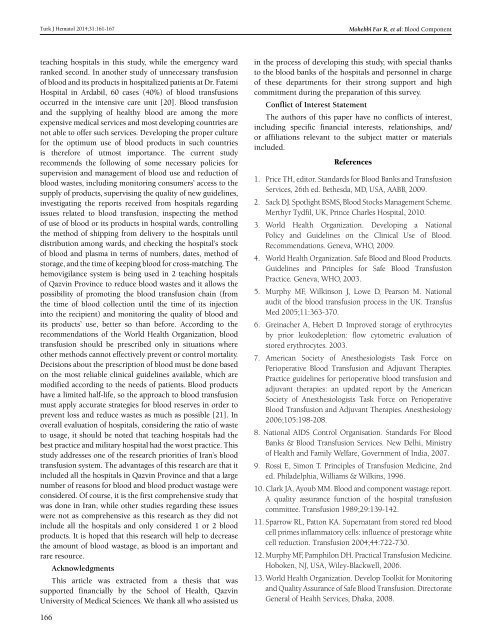Turkish Journal of Hematology Volume: 31 - Issue: 2
You also want an ePaper? Increase the reach of your titles
YUMPU automatically turns print PDFs into web optimized ePapers that Google loves.
Turk J Hematol 2014;<strong>31</strong>:161-167<br />
Mohebbi Far R, et al: Blood Component<br />
teaching hospitals in this study, while the emergency ward<br />
ranked second. In another study <strong>of</strong> unnecessary transfusion<br />
<strong>of</strong> blood and its products in hospitalized patients at Dr. Fatemi<br />
Hospital in Ardabil, 60 cases (40%) <strong>of</strong> blood transfusions<br />
occurred in the intensive care unit [20]. Blood transfusion<br />
and the supplying <strong>of</strong> healthy blood are among the more<br />
expensive medical services and most developing countries are<br />
not able to <strong>of</strong>fer such services. Developing the proper culture<br />
for the optimum use <strong>of</strong> blood products in such countries<br />
is therefore <strong>of</strong> utmost importance. The current study<br />
recommends the following <strong>of</strong> some necessary policies for<br />
supervision and management <strong>of</strong> blood use and reduction <strong>of</strong><br />
blood wastes, including monitoring consumers’ access to the<br />
supply <strong>of</strong> products, supervising the quality <strong>of</strong> new guidelines,<br />
investigating the reports received from hospitals regarding<br />
issues related to blood transfusion, inspecting the method<br />
<strong>of</strong> use <strong>of</strong> blood or its products in hospital wards, controlling<br />
the method <strong>of</strong> shipping from delivery to the hospitals until<br />
distribution among wards, and checking the hospital’s stock<br />
<strong>of</strong> blood and plasma in terms <strong>of</strong> numbers, dates, method <strong>of</strong><br />
storage, and the time <strong>of</strong> keeping blood for cross-matching. The<br />
hemovigilance system is being used in 2 teaching hospitals<br />
<strong>of</strong> Qazvin Province to reduce blood wastes and it allows the<br />
possibility <strong>of</strong> promoting the blood transfusion chain (from<br />
the time <strong>of</strong> blood collection until the time <strong>of</strong> its injection<br />
into the recipient) and monitoring the quality <strong>of</strong> blood and<br />
its products’ use, better so than before. According to the<br />
recommendations <strong>of</strong> the World Health Organization, blood<br />
transfusion should be prescribed only in situations where<br />
other methods cannot effectively prevent or control mortality.<br />
Decisions about the prescription <strong>of</strong> blood must be done based<br />
on the most reliable clinical guidelines available, which are<br />
modified according to the needs <strong>of</strong> patients. Blood products<br />
have a limited half-life, so the approach to blood transfusion<br />
must apply accurate strategies for blood reserves in order to<br />
prevent loss and reduce wastes as much as possible [21]. In<br />
overall evaluation <strong>of</strong> hospitals, considering the ratio <strong>of</strong> waste<br />
to usage, it should be noted that teaching hospitals had the<br />
best practice and military hospital had the worst practice. This<br />
study addresses one <strong>of</strong> the research priorities <strong>of</strong> Iran’s blood<br />
transfusion system. The advantages <strong>of</strong> this research are that it<br />
included all the hospitals in Qazvin Province and that a large<br />
number <strong>of</strong> reasons for blood and blood product wastage were<br />
considered. Of course, it is the first comprehensive study that<br />
was done in Iran, while other studies regarding these issues<br />
were not as comprehensive as this research as they did not<br />
include all the hospitals and only considered 1 or 2 blood<br />
products. It is hoped that this research will help to decrease<br />
the amount <strong>of</strong> blood wastage, as blood is an important and<br />
rare resource.<br />
Acknowledgments<br />
This article was extracted from a thesis that was<br />
supported financially by the School <strong>of</strong> Health, Qazvin<br />
University <strong>of</strong> Medical Sciences. We thank all who assisted us<br />
in the process <strong>of</strong> developing this study, with special thanks<br />
to the blood banks <strong>of</strong> the hospitals and personnel in charge<br />
<strong>of</strong> these departments for their strong support and high<br />
commitment during the preparation <strong>of</strong> this survey.<br />
Conflict <strong>of</strong> Interest Statement<br />
The authors <strong>of</strong> this paper have no conflicts <strong>of</strong> interest,<br />
including specific financial interests, relationships, and/<br />
or affiliations relevant to the subject matter or materials<br />
included.<br />
References<br />
1. Price TH, editor. Standards for Blood Banks and Transfusion<br />
Services, 26th ed. Bethesda, MD, USA, AABB, 2009.<br />
2. Sack DJ. Spotlight BSMS, Blood Stocks Management Scheme.<br />
Merthyr Tydfil, UK, Prince Charles Hospital, 2010.<br />
3. World Health Organization. Developing a National<br />
Policy and Guidelines on the Clinical Use <strong>of</strong> Blood.<br />
Recommendations. Geneva, WHO, 2009.<br />
4. World Health Organization. Safe Blood and Blood Products.<br />
Guidelines and Principles for Safe Blood Transfusion<br />
Practice. Geneva, WHO, 2003.<br />
5. Murphy MF, Wilkinson J, Lowe D, Pearson M. National<br />
audit <strong>of</strong> the blood transfusion process in the UK. Transfus<br />
Med 2005;11:363-370.<br />
6. Greinacher A, Hebert D. Improved storage <strong>of</strong> erythrocytes<br />
by prior leukodepletion: flow cytometric evaluation <strong>of</strong><br />
stored erythrocytes. 2003.<br />
7. American Society <strong>of</strong> Anesthesiologists Task Force on<br />
Perioperative Blood Transfusion and Adjuvant Therapies.<br />
Practice guidelines for perioperative blood transfusion and<br />
adjuvant therapies: an updated report by the American<br />
Society <strong>of</strong> Anesthesiologists Task Force on Perioperative<br />
Blood Transfusion and Adjuvant Therapies. Anesthesiology<br />
2006;105:198-208.<br />
8. National AIDS Control Organisation. Standards For Blood<br />
Banks & Blood Transfusion Services. New Delhi, Ministry<br />
<strong>of</strong> Health and Family Welfare, Government <strong>of</strong> India, 2007.<br />
9. Rossi E, Simon T. Principles <strong>of</strong> Transfusion Medicine, 2nd<br />
ed. Philadelphia, Williams & Wilkins, 1996.<br />
10. Clark JA, Ayoub MM. Blood and component wastage report.<br />
A quality assurance function <strong>of</strong> the hospital transfusion<br />
committee. Transfusion 1989;29:139-142.<br />
11. Sparrow RL, Patton KA. Supernatant from stored red blood<br />
cell primes inflammatory cells: influence <strong>of</strong> prestorage white<br />
cell reduction. Transfusion 2004;44:722-730.<br />
12. Murphy MF, Pamphilon DH. Practical Transfusion Medicine.<br />
Hoboken, NJ, USA, Wiley-Blackwell, 2006.<br />
13. World Health Organization. Develop Toolkit for Monitoring<br />
and Quality Assurance <strong>of</strong> Safe Blood Transfusion. Directorate<br />
General <strong>of</strong> Health Services, Dhaka, 2008.<br />
166

















